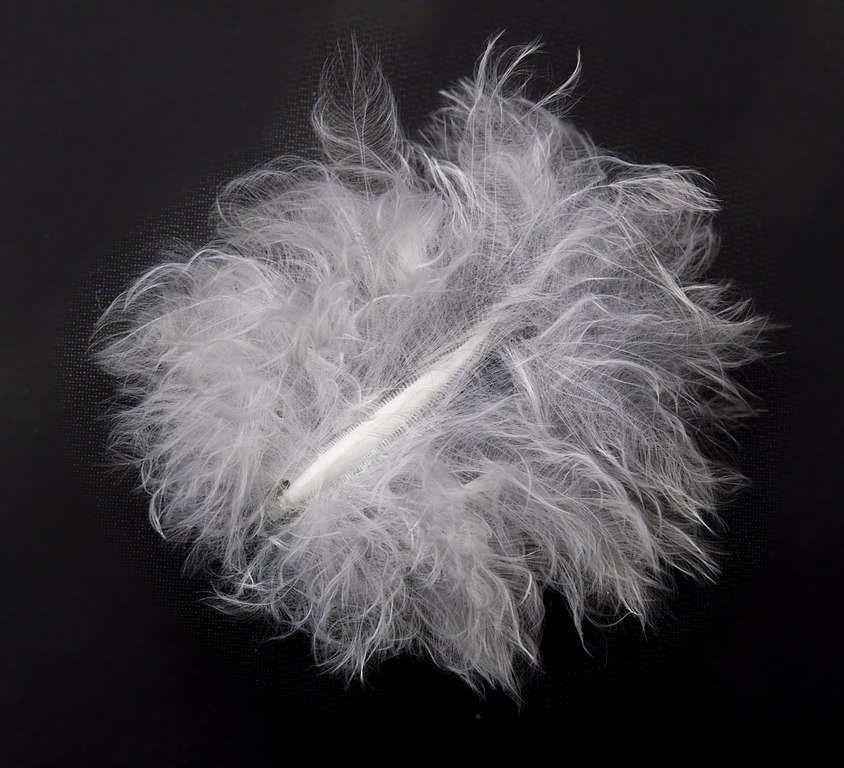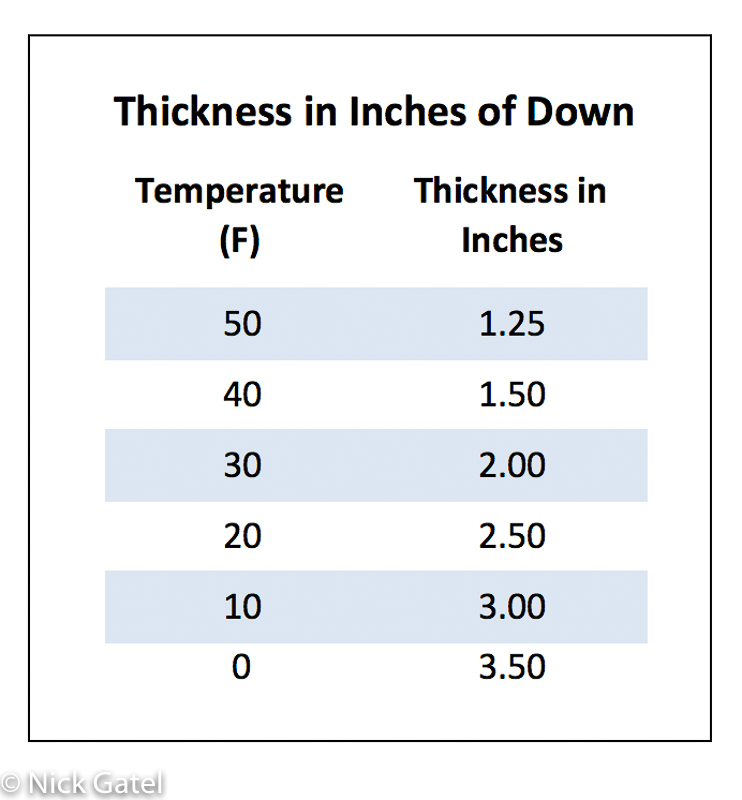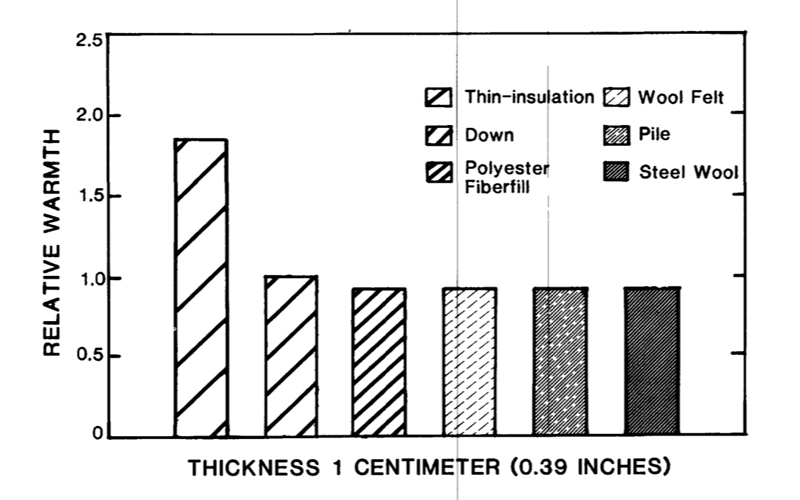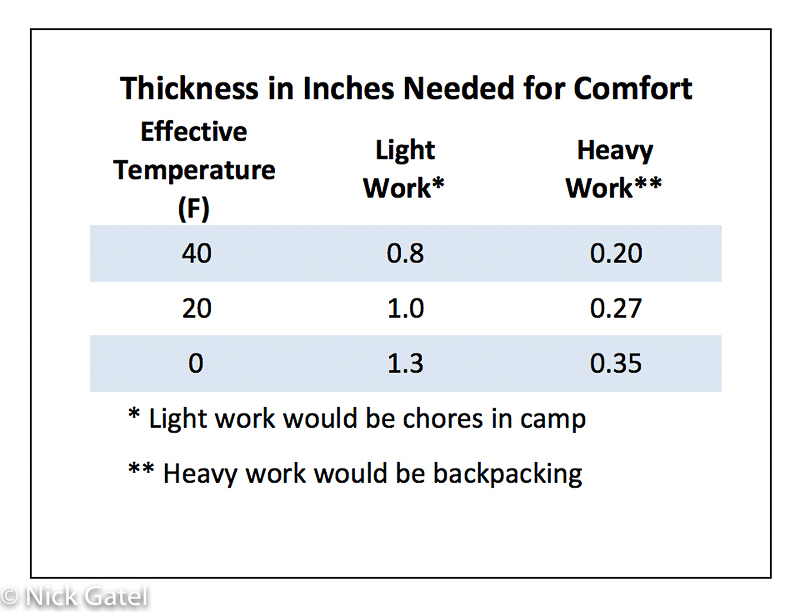
Recently an acquaintance asked me to help him find a suitable down jacket for backpacking when nighttime temperatures could dip down to 20° F (6.7° C). He wanted a 900 or higher fill power garment because, “The higher the fill power, the warmer the garment.”
But is this true? All things being equal, not really. The most important factor is the thickness of the insulation, not fill power.
In this post I will explain fill power, insulation thickness, and the difficulty of shopping for suitable equipment because the equipment manufacturers (clothing, sleeping bags, and quilts) try to confuse us with worthless marketing instead of useful facts.
Data Sources
Back in 2020 I wrote an article titled, Understanding Layers Using Patagonia Clothing as a Guide.
It is a lengthy post and much of the data comes from a study done in 1969 (revised in 1973) done by the United States Army Natick Laboratory, The Comfort and Function of Clothing (Tech Report 69-74-CE). The study is quite long at over 300 pages. It was from this study that I created several tables to explain insulation. I will share some of these tables in this article.
Down Fill Power
Down Fill Power is the “quality of down.” Using standardized testing procedures, fill power is the volume of space one ounce of down fill will fill. Thus, one ounce of 900 Fill Power will have a volume of 900 cubic inches. One ounce of 600 Fill Power has a volume of 600 cubic inches.
900 Fill Power has higher quality down than 600 Fill Power. The former has a larger average size of down feathers.

The highest quality down comes from geese. More and more manufacturers, given the high demand and cost of goose down, are using duck down in combination with goose down or instead of goose down. The individual duck down under feathers are smaller than goose down. Also, duck down needs special cleaning or it will cause an unpleasant smell.
The down fill power doesn’t really tell us much if we are looking to buy a garment or sleeping bag. Not only do manufacturers rarely disclose how much down (weight) is used, it is even rarer for them to disclose the average thickness of the down through the item.
If you want to read more about Down Fill Power, this article from REI (Recreational Equipment, Inc.) is pretty good.
How Insulation Works
When placed between two layers of fabric, the insulation creates an air space between the layers, that is, the insulation is sandwiched between two layers of fabric. The loft of the insulation creates an air space that will capture our body heat. Better insulation will also slow the movement of heat through the insulation, which will eventually pass through the upper fabric layer opposite of our body.
The Importance of Insulation Thickness
In general, the thickness of the insulation determines how warm a garment or sleeping bag will be. One inch thickness of goose down, duck down, chicken down, man-made polyester fill, cotton batting, or even steel wool will provide close to the same amount of warmth.
Why High Quality Goose Down is Usually the Best Insulator
When down gets damp or wet its insulation properties are nil. It is a poor material in climates where you cannot keep it dry. But if you can keep it dry it is the best because it looses very little loft over time, to include frequent compression when stuffing it into a storage bag or backpack. Not only does it pack into a small volume, but it easily and quickly can regain its full loft.
Man-Made Insulation
Man-made insulations such as Polarguard® 3D and Climashield® Apex will insulate just as well as goose down if the insulation thickness are the same. These man-made materials will also provide some insulation when wet.
But these man-made solutions are heavier than down (weight for an amount of volume), don’t compress as much as down, and quickly lose the amount of loft it can achieve. Man-made insulation is also much less expensive than down.
How Much Insulation (Thickness) do you Need?
(The tables below apply to the average male. Typically women need more insulation, but not always). Although not very scientific, we can generally say the thickness of an insulator will be almost the same, no matter what material is used. Here is a 1978 chart from 3M, the manufacturer of Thinsulate insulation. The high loft materials (every thing except Thinsulate) comes from that 1969 Natick paper.
Thin insulation, such as Thinsulate, has much, much thinner fibers than down, polyester, and most other “high-loft” insulation. Thus, it is called “thin-loft insulation.” The problem with Thinsulate is it is much heavier in weight compared to the common insulation used today in backpacking clothes. So you rarely will see it in backpacking clothing. You will see it in gloves, boots, and even shoe insoles.
Below are some tables I created for my Understanding Layers Using Patagonia Clothing as a Guide article. There are three things I must point out, and the above article will explain them further. The more active we are, the less insulation we need. For backpackers, there are usually three activity categories that are important to note:
- Light Work
- Heavy Work
- Inactive (sleeping)
Because this is a rough guesstimate, we can extrapolate that at freezing (32° F), we need around .90 inches of insulation for camp chores and .23 inches while backpacking.
I used similar calculations for sleeping bags, where we are not doing any work, so the insulation needs to be much thicker:
Table 2 (Sleeping Bag Insulation)
We need more insulation in sleeping bags because our bodies generate less heat. The chart in Table 1 showed inches of insulation needed for light work and heavy work. We need even more insulation is we are just sitting, and even more when lying down (sleeping).
This methodology of inches isn’t very scientific given today’s modern fabrics, but a fusion of some science and a lot of field experience. Through the ‘70s until the late ‘90s, when I was refining my garments and sleeping bags, there wasn’t an Internet to provide the information we can get today.
Sleeping Bag EN (or ISO) Ratings
Unlike garments, there are actual standards for temperature-rating sleeping bags. However, the test procedures are complicated and really can’t tell us if a specific sleeping bag will be warm enough for a particular person.
What these ratings can do is provide us is a method to compare two different sleeping bags.
For an in-depth review of these standards, this comprehensive article by Rex Sanders at Backpackinglight.com is excellent (subscription required). For a quick overview, this REI page has a summary.
Insulation in the Real World
Unfortunately each individual is different when it comes to determining what thickness of insulation will meet the needs for specific activities and certain temperatures. It eventually comes down to experience with different garments and sleeping bags.
Add to this the fact that most of the specialized gear for backpackers is mostly sold online these days. But here are some things to think about.
Western Mountaineering Sleeping Bags
For over 50 years Western Mountaineering has been one of the premier (the premier in my opinion) manufacturers of quality sleeping bags. My current favorite sleeping bag is a Western Mountaineering UltraLite (20° F rated). It isn’t my only one, as I have a couple other ones for warmer temperatures.
Let’s take a look at the specifications for this sleeping bag:

The loft is shown as 5 inches at the top of the Western Mountaineering spec sheet, which matches the Natick Data Lab Report, but in WM’s table below it, it shows 5.5 inches. I have noticed this in most of their sleeping bags. Since it is insulated top and bottom, the insulation thickness is 2.5 inches or 2.75 inches using their table. From my table on sleeping bag thicknesses posted earlier, the UltraLite, using the 5 inch number matches the insulation value of 2.5 inches for 20° F provided in the Natick Lab report. So why the difference? Perhaps WM’s explanation of their Down Fill Power will add some clarification:
Western Mountaineering is specialized enough that we can ask for our suppliers to give us the best down they can get. This creates an average yield that is almost always above 900 fill power. We state 850+ on our products because even though the down tests out at 900 or over, the ‘real’ loft power is different. Once the down is inside a bag or jacket baffle it is compressed slightly by the fabric. Loft is also affected by real world humidity conditions that are not present during loft testing.
Also take notice that Western Mountaineering also includes the fill weight and total weight. For 6’0″ bag it is 15 oz. and 1 lb. 12 oz. respectively.
Western Mountaineering uses what the call 850+ Fill Power. It actually tests at 900+ Fill Power, but they take into consideration that it can compress slightly when actually in use.
Here’s a link to the table of specifications for all of Western Mountaineering’s sleeping bags and quilts.
While Western Mountaineering makes it easy to compare all of their sleeping bags, they don’t provide this detail of information for their clothing.
Montbell Down Jackets
Here is an interesting comparison from Montbell USA. They sell three different “down sweater weight warmth” down jackets.

Montbell states that each provides about the warmth of a sweater and the 650 Fill Power Down Highland Jacket is slightly warmer than the other two!
Technically, the Highland is a little bit warmer than the Plasma and the Superior, but roughly they provide about the same level of warmth. We categorize these three jackets in our sweater weight warmth category because they provide the equivalent warmth of a sweater. What we need to think about is how much down is inside each jacket. Although the Plasma is filled with 1000 fill power down, it only needs 1.6 oz (45 g) of down to fill up the volume inside the jacket. On the other hand, in order to fill the volume inside the Superior, we need 1.9 oz (55 g) of 800 fill power down. For the Highland, we need to use 3 oz (85 g) of 650 fill power down.
How about price?
- Plasma 1000 Down Jacket = $369
- Superior 800 Down Jacket = $219
- Highland 650 Down Jacket = $149
All for the same warmth, but the Plasma weight only 39% of the Highland’s weight at 2.5 times the cost of the Highland.
I own a 10+ year old Montbell Extremely Light Down (900 Fill Power) Jacket. It is about 1/2 inch thick. I also own a Patagonia Down (800 Fill Power) Sweater. At .75 inches thick, the Patagonia is warmer than the 900 Fill Power Montbell. Also the Montbell is made from a much lighter material and does not have pockets (less weight) like the Patagonia Down Sweater. The Montbell weighs 6.1 ounces and the Patagonia is 12.1 ounces, which almost twice as heavy as the Montbell.
Another reason for sharing this last comparison is that Montbell calls their lightweight down jackets “down sweater weight warmth” and Patagonia calls its jacket a down sweater — so the term sweater has no standardized definition.
If you want to compare garments or sleeping bags — focus on the thickness of the insulations. Everything else falls under the categories of features and benefits.

